Characterization of WO3/Silicone Rubber Composites for Hydrogen-Sensitive Gasochromic Application
Abstract
:1. Introduction
2. Results
2.1. Micromorphological Analyses
2.2. Mechanical Properties
2.3. Hydrogen Penetration Characteristics
2.4. Gasochromic Performance
2.5. Practical Application
3. Materials and Methods
3.1. Materials
3.2. Preparation of the Composites
3.3. Characterization and Measurements
4. Conclusions
Supplementary Materials
Author Contributions
Funding
Institutional Review Board Statement
Informed Consent Statement
Data Availability Statement
Conflicts of Interest
References
- Rosen, M.A.; Koohi-Fayegh, S. The Prospects for Hydrogen as an Energy Carrier: An Overview of Hydrogen Energy and Hydrogen Energy Systems. Energy Ecol. Environ. 2016, 1, 10–29. [Google Scholar] [CrossRef]
- Cheng, C.; An, R.; Dong, K.; Wang, K. Can the Future Be Bright? Evolutionary Game Analysis of Multi-Stakeholders in the Blue and Green Hydrogen Development. Int. J. Hydrogen Energy 2024, 67, 294–311. [Google Scholar] [CrossRef]
- San Marchi, C.; Hecht, E.S.; Ekoto, I.W.; Groth, K.M.; LaFleur, C.; Somerday, B.P.; Mukundan, R.; Rockward, T.; Keller, J.; James, C.W. Overview of the DOE Hydrogen Safety, Codes and Standards Program, Part 3: Advances in Research and Development to Enhance the Scientific Basis for Hydrogen Regulations, Codes and Standards. Int. J. Hydrogen Energy 2017, 42, 7263–7274. [Google Scholar] [CrossRef]
- Ishaq, H.; Dincer, I.; Crawford, C. A Review on Hydrogen Production and Utilization: Challenges and Opportunities. Int. J. Hydrogen Energy 2022, 47, 26238–26264. [Google Scholar] [CrossRef]
- Hübert, T.; Boon-Brett, L.; Black, G.; Banach, U. Hydrogen Sensors—A Review. Sens. Actuators B Chem. 2011, 157, 329–352. [Google Scholar] [CrossRef]
- Buttner, W.J.; Post, M.B.; Burgess, R.; Rivkin, C. An Overview of Hydrogen Safety Sensors and Requirements. Int. J. Hydrogen Energy 2011, 36, 2462–2470. [Google Scholar] [CrossRef]
- Hwan Cho, S.; Min Suh, J.; Jeong, B.; Hyung Lee, T.; Soon Choi, K.; Hoon Eom, T.; Kim, T.; Won Jang, H. Fast Responding and Highly Reversible Gasochromic H2 Sensor Using Pd-Decorated Amorphous WO3 Thin Films. Chem. Eng. J. 2022, 446, 136862. [Google Scholar] [CrossRef]
- Lee, Y.-A.; Kalanur, S.S.; Shim, G.; Park, J.; Seo, H. Highly Sensitive Gasochromic H2 Sensing by Nano-Columnar WO3-Pd Films with Surface Moisture. Sens. Actuators B Chem. 2017, 238, 111–119. [Google Scholar] [CrossRef]
- Gao, C.; Guo, X.; Nie, L.; Wu, X.; Peng, L.; Chen, J. A Review on WO3 Gasochromic Film: Mechanism, Preparation and Properties. Int. J. Hydrogen Energy 2023, 48, 2442–2465. [Google Scholar] [CrossRef]
- Xue, S.; Gao, G.; Zhang, Z.; Jiang, X.; Shen, J.; Wu, G.; Dai, H.; Xu, Y.; Xiao, Y. Nanoporous WO3 Gasochromic Films for Gas Sensing. ACS Appl. Nano Mater. 2021, 4, 8368–8375. [Google Scholar] [CrossRef]
- Li, J.; Guo, C.; Li, L.; Gu, Y.; Kim, B.-H.; Huang, J. Synthesis of Vertical WO3 Nanoarrays with Different Morphologies Using the Same Protocol for Enhanced Photocatalytic and Photoelectrocatalytic Performances. RSC Adv. 2021, 11, 23700–23706. [Google Scholar] [CrossRef] [PubMed]
- Bahadur, A.; Anjum, T.A.; Roosh, M.; Iqbal, S.; Alrbyawi, H.; Qayyum, M.A.; Ahmad, Z.; Al-Anazy, M.M.; Elkaeed, E.B.; Pashameah, R.A.; et al. Magnetic, Electronic, and Optical Studies of Gd-Doped WO3: A First Principle Study. Molecules 2022, 27, 6976. [Google Scholar] [CrossRef]
- Najafi-Ashtiani, H.; Bahari, A.; Ghasemi, S. A Dual Electrochromic Film Based on Nanocomposite of Aniline and O-Toluidine Copolymer with Tungsten Oxide Nanoparticles. Org. Electron. 2016, 37, 213–221. [Google Scholar] [CrossRef]
- Nwanya, A.C.; Jafta, C.J.; Ejikeme, P.M.; Ugwuoke, P.E.; Reddy, M.V.; Osuji, R.U.; Ozoemena, K.I.; Ezema, F.I. Electrochromic and Electrochemical Capacitive Properties of Tungsten Oxide and Its Polyaniline Nanocomposite Films Obtained by Chemical Bath Deposition Method. Electrochimica Acta 2014, 128, 218–225. [Google Scholar] [CrossRef]
- Su, P.-G.; Peng, Y.-T. Fabrication of a Room-Temperature H2S Gas Sensor Based on PPy/WO3 Nanocomposite Films by in-Situ Photopolymerization. Sens. Actuators B Chem. 2014, 193, 637–643. [Google Scholar] [CrossRef]
- Hung, T.-T.; Chung, M.-H.; Chiu, J.-J.; Yang, M.-W.; Tien, T.-N.; Shen, C.-Y. Poly(4-Styrenesulfonic Acid) Doped Polypyrrole/Tungsten Oxide/Reduced Graphene Oxide Nanocomposite Films Based Surface Acoustic Wave Sensors for NO Sensing Behavior. Org. Electron. 2021, 88, 106006. [Google Scholar] [CrossRef]
- Yin, H.Y.; Song, X.C.; Zheng, Y.F.; Wang, X.; Yang, Z.A.; Ma, R. Organic/Inorganic Nanocomposite Films Based on Poly(3-Methoxythiophene) and WO3. Mater. Sci. Eng. B 2011, 176, 684–687. [Google Scholar] [CrossRef]
- Mane, A.T.; Navale, S.T.; Patil, V.B. Room Temperature NO2 Gas Sensing Properties of DBSA Doped PPy–WO3 Hybrid Nanocomposite Sensor. Org. Electron. 2015, 19, 15–25. [Google Scholar] [CrossRef]
- Khan, H.U.; Tariq, M.; Shah, M.; Ullah, S.; Ahsan, A.R.; Rahim, A.; Iqbal, J.; Pasricha, R.; Ismail, I. Designing and Development of Polyvinylpyrrolidone-Tungsten Trioxide (PVP-WO3) Nanocomposite Conducting Film for Highly Sensitive, Stable, and Room Temperature Humidity Sensing. Mater. Sci. Semicond. Process. 2021, 134, 106053. [Google Scholar] [CrossRef]
- Kozlov, D.A.; Shcherbakov, A.B.; Kozlova, T.O.; Angelov, B.; Kopitsa, G.P.; Garshev, A.V.; Baranchikov, A.E.; Ivanova, O.S.; Ivanov, V.K. Photochromic and Photocatalytic Properties of Ultra-Small PVP-Stabilized WO3 Nanoparticles. Molecules 2019, 25, 154. [Google Scholar] [CrossRef]
- Li, Y.; Zhang, Z.; Zhu, J. Broadband Optical Limiting Properties of Tungsten Trioxide-Poly (Vinyl Alcohol) Solid-State Nanocomposite Films. Opt. Mater. 2021, 119, 111359. [Google Scholar] [CrossRef]
- Crasta, V.; Praveen, B.M. Enhancement of Optical, Mechanical and Micro Structural Properties in Nanocomposite Films of PVA Doped with WO3 Nanoparticles. Int. J. Struct. Integr. 2015, 6, 338–354. [Google Scholar] [CrossRef]
- Yano, S.; Kurita, K.; Iwata, K.; Furukawa, T.; Kodomari, M. Structure and Properties of Poly(Vinyl Alcohol)/Tungsten Trioxide Hybrids. Polymer 2003, 44, 3515–3522. [Google Scholar] [CrossRef]
- Thakur, P.; Kool, A.; Bagchi, B.; Hoque, N.A.; Das, S.; Nandy, P. Improvement of Electroactive β Phase Nucleation and Dielectric Properties of WO3·H 2 O Nanoparticle Loaded Poly(Vinylidene Fluoride) Thin Films. RSC Adv. 2015, 5, 62819–62827. [Google Scholar] [CrossRef]
- Lee, J.; Koo, H.; Kim, S.Y.; Kim, S.J.; Lee, W. Electrostatic Spray Deposition of Chemochromic WO3-Pd Sensor for Hydrogen Leakage Detection at Room Temperature. Sens. Actuators B Chem. 2021, 327, 128930. [Google Scholar] [CrossRef]
- Belov, N.A.; Tarasenkov, A.N.; Tebeneva, N.A.; Vasilenko, N.G.; Shandryuk, G.A.; Yampolskii, Y.P.; Muzafarov, A.M. Synthesis and Gas-Transport Properties of Iron- and Zirconium-Containing Polydimethylsiloxanes. Polym. Sci. Ser. B 2018, 60, 405–413. [Google Scholar] [CrossRef]
- Berean, K.; Ou, J.Z.; Nour, M.; Latham, K.; McSweeney, C.; Paull, D.; Halim, A.; Kentish, S.; Doherty, C.M.; Hill, A.J.; et al. The Effect of Crosslinking Temperature on the Permeability of PDMS Membranes: Evidence of Extraordinary CO2 and CH4 Gas Permeation. Sep. Purif. Technol. 2014, 122, 96–104. [Google Scholar] [CrossRef]
- Cao, P.-F.; Li, B.; Hong, T.; Xing, K.; Voylov, D.N.; Cheng, S.; Yin, P.; Kisliuk, A.; Mahurin, S.M.; Sokolov, A.P.; et al. Robust and Elastic Polymer Membranes with Tunable Properties for Gas Separation. ACS Appl. Mater. Interfaces 2017, 9, 26483–26491. [Google Scholar] [CrossRef] [PubMed]
- Liu, G.; Zhou, T.; Liu, W.; Hu, S.; Pan, F.; Wu, H.; Jiang, Z.; Wang, B.; Yang, J.; Cao, X. Enhanced Desulfurization Performance of PDMS Membranes by Incorporating Silver Decorated Dopamine Nanoparticles. J. Mater. Chem. A 2014, 2, 12907. [Google Scholar] [CrossRef]
- Prajapati, P.K.; Kansara, A.M.; Aswal, V.K.; Singh, P.S. Effect of Zeolitic Imidazole Framework-8 Nanocrystals on Hydrocarbon Permselective Poly(Dimethylsiloxane) Membrane as Probed by Small-Angle Neutron Scattering. Polymer 2018, 143, 96–105. [Google Scholar] [CrossRef]
- Heidari, M.; Hosseini, S.S.; Omidkhah Nasrin, M.; Ghadimi, A. Synthesis and Fabrication of Adsorptive Carbon Nanoparticles (ACNs)/PDMS Mixed Matrix Membranes for Efficient CO2/CH4 and C3H8/CH4 Separation. Sep. Purif. Technol. 2019, 209, 503–515. [Google Scholar] [CrossRef]
- Shen, G.; Zhao, J.; Guan, K.; Shen, J.; Jin, W. Highly Efficient Recovery of Propane by Mixed-matrix Membrane via Embedding Functionalized Graphene Oxide Nanosheets into Polydimethylsiloxane. AIChE J. 2017, 63, 3501–3510. [Google Scholar] [CrossRef]
- Wang, L.; An, F.; Liu, X.; Zhang, D.; Yang, Z. Preparation and Hydrogen-Sensitive Property of WO3/Graphene/Pd Ternary Composite. Chemosensors 2023, 11, 410. [Google Scholar] [CrossRef]
- Tang, M.; Zhang, D.; Chen, Q.; Wang, Z.; Wang, D.; Yang, Z.; Xu, W.; Wang, L.; Zhu, L.; An, F. Heterostructure Construction of SnS2 Debye Nanowires Modified with ZnO Nanorods for Chemiresistive H2S Detection in Sulfur Hexafluoride Decomposition Products. Sens. Actuators B Chem. 2023, 390, 133952. [Google Scholar] [CrossRef]
- Liu, H.; Yang, Z.; Wang, L.; Yu, P.; Kang, Z.; Wu, Q.; Kuang, C.; Yu, A. Gasochromic Hydrogen Sensors: Fundamentals, Recent Advances, and Perspectives. Sens. Mater. 2023, 35, 39. [Google Scholar] [CrossRef]
- Liu, D.; Geng, Z.; Han, A.; Yu, P.; Zhang, K.; Liu, H.; Liu, Y. Rational Regulation of Tungsten Oxides with Specific Exposed Facets for the Investigation of Morphology-Dependent Hydrogen Gasochromic Performance. Int. J. Hydrogen Energy 2024, 60, 20–27. [Google Scholar] [CrossRef]
- GB/T 528; Rubber, Vulcanized or Thermoplastic-Determination of Tensile Stress-Strain Properties. Standardization Administration of China: Beijing, China, 2009.
- ISO 2285; Rubber, Vulcanized or Thermoplastic-Determination of Tension Set at Normal and High Temperatures. International Organization for Standardization: Geneva, Switzerland, 2019.
- Meraje, W.C.; Huang, C.-C.; Ahmad, N.; Dewangga, G.R.S.; Kuo, C.-F.J. Hybrid Sol-Gel-Derived Method for the Synthesis of Silicon Rubber Composites with hBN for Characteristic Applications in Elastomeric Thermal Pads. Text. Res. J. 2022, 92, 2061–2079. [Google Scholar] [CrossRef]
- GB/T 1038; Plastics-Film and Sheeting-Determination of Gas Transmission-Differential-Pressure Method. Standardization Administration of China: Beijing, China, 2000.
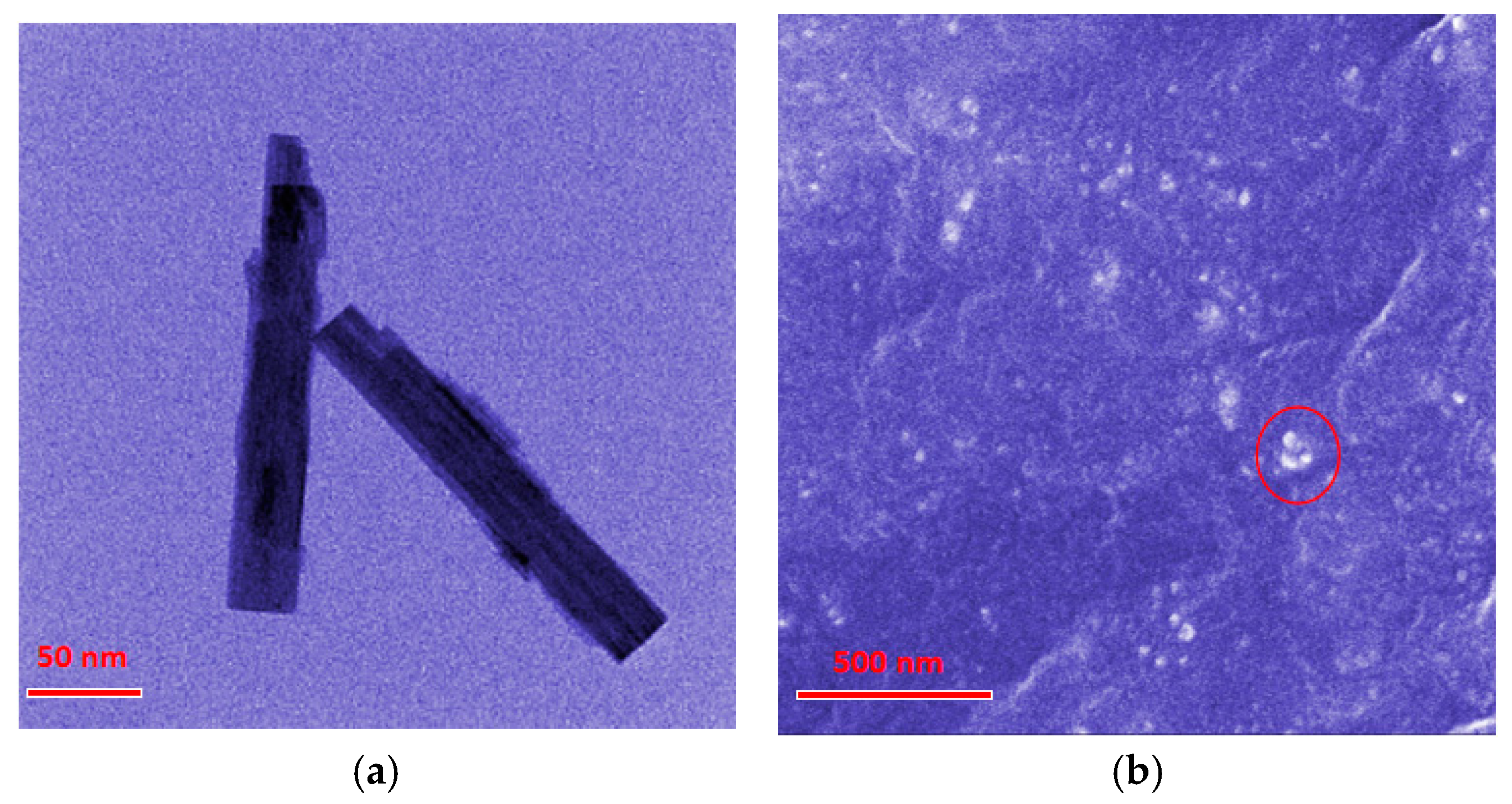
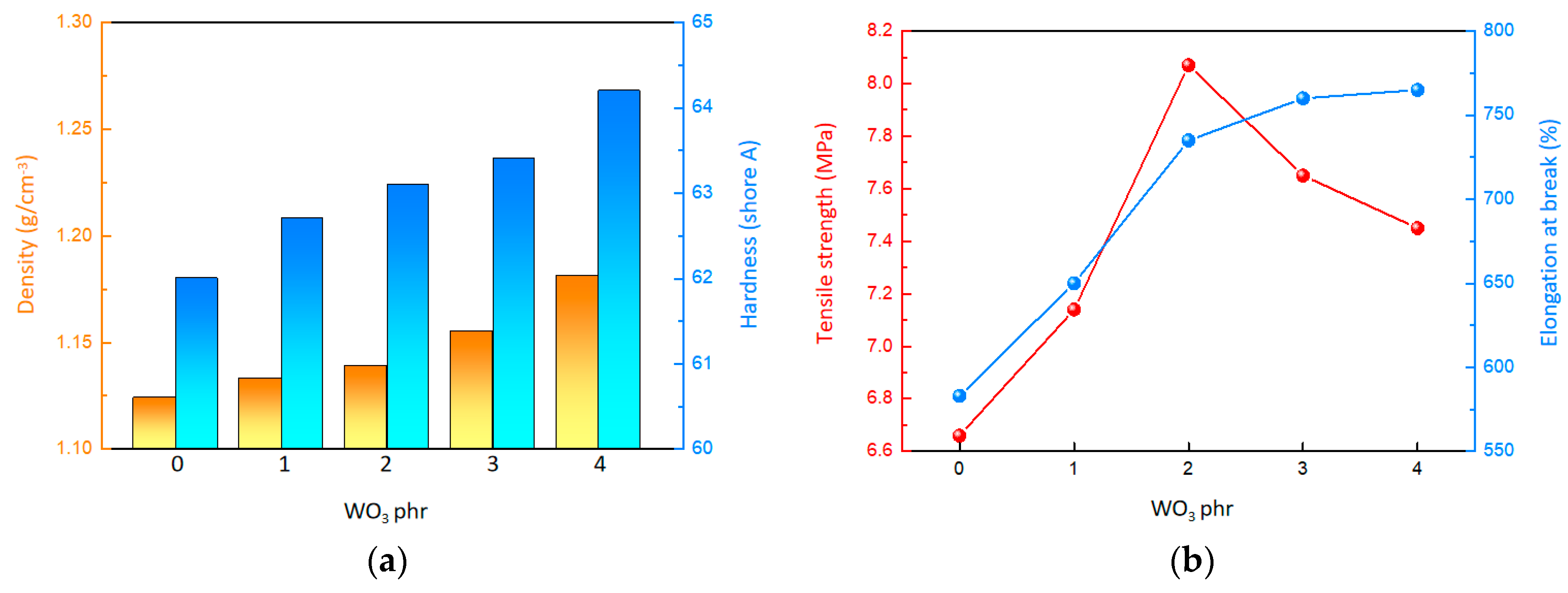
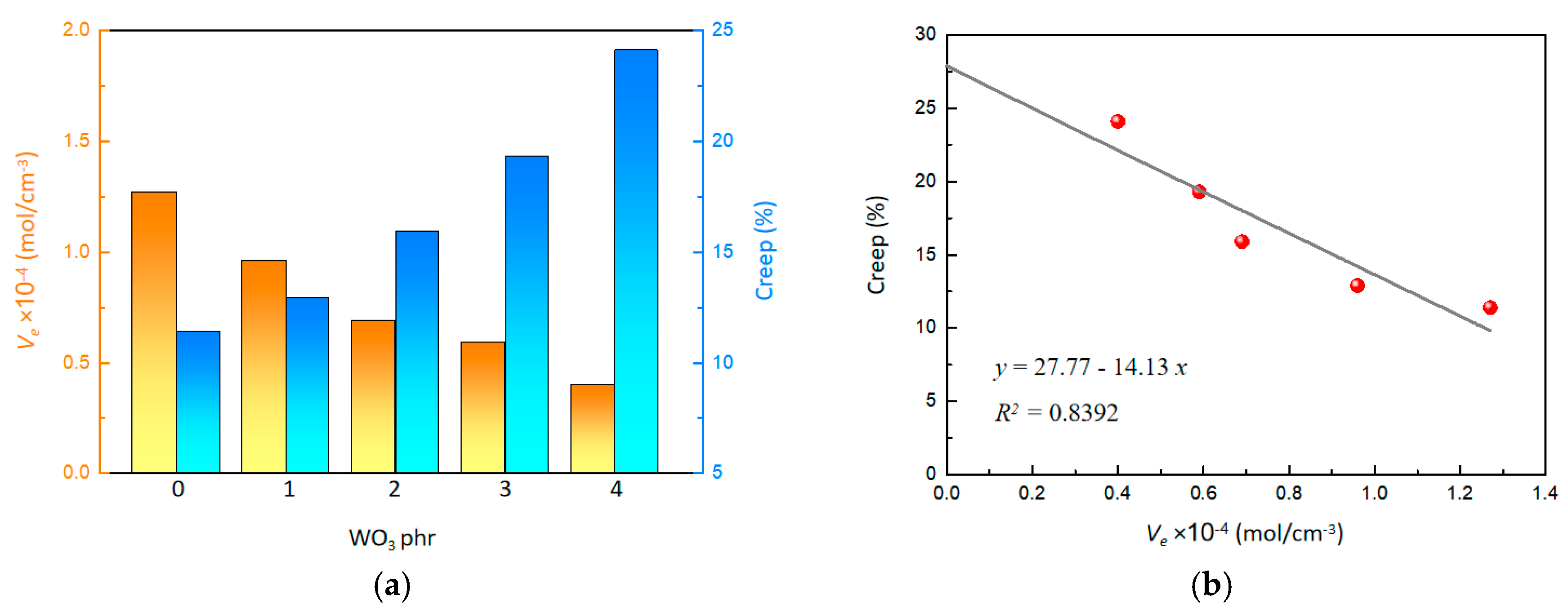




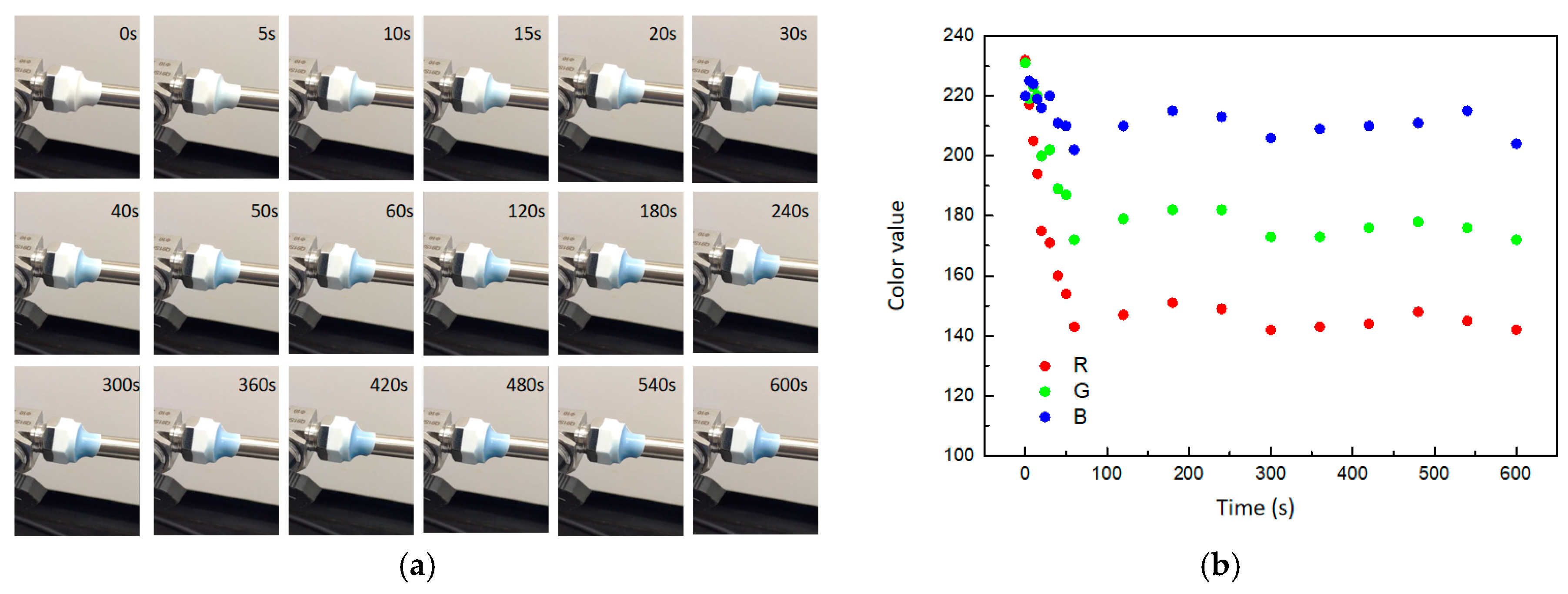
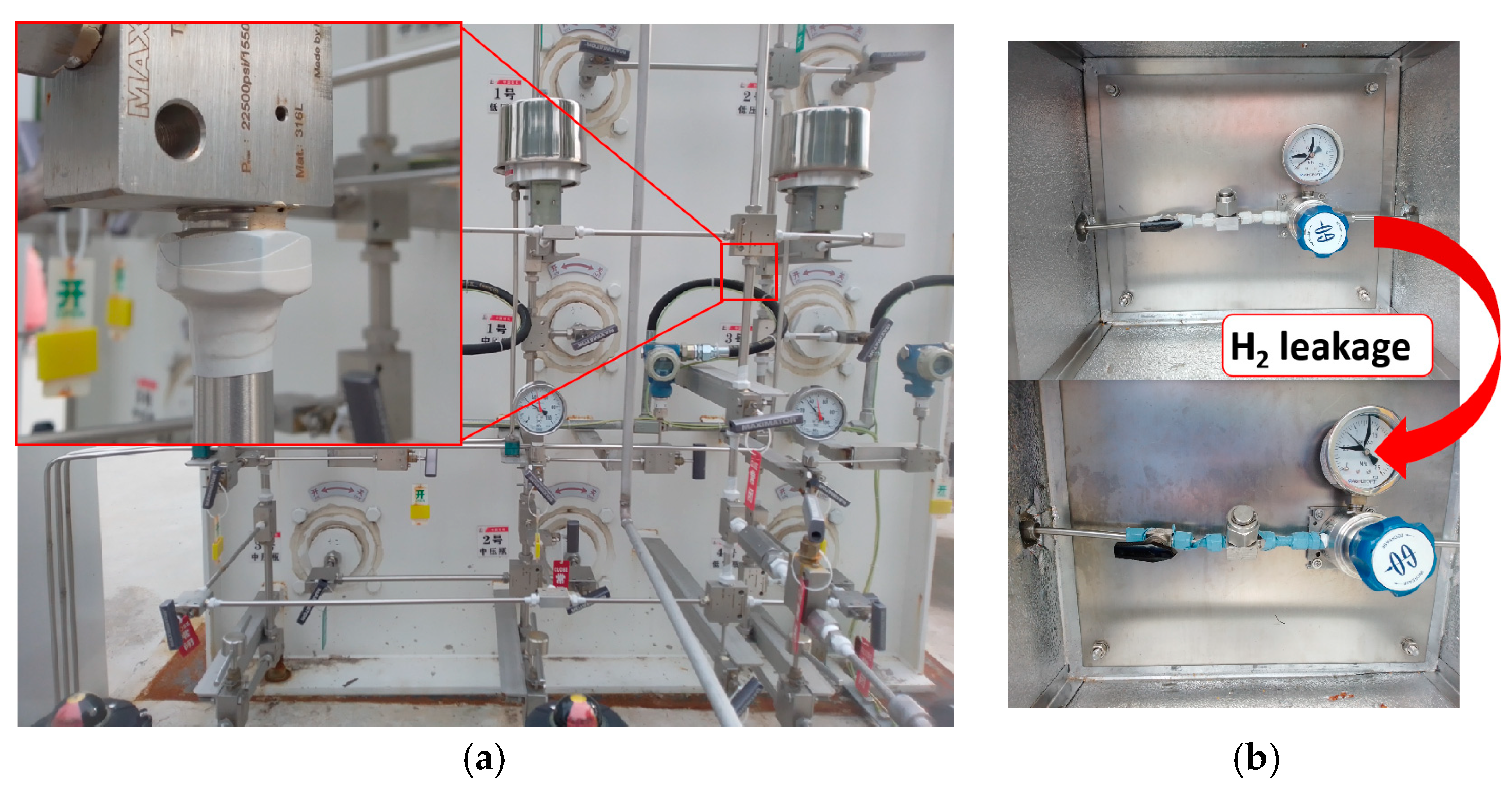
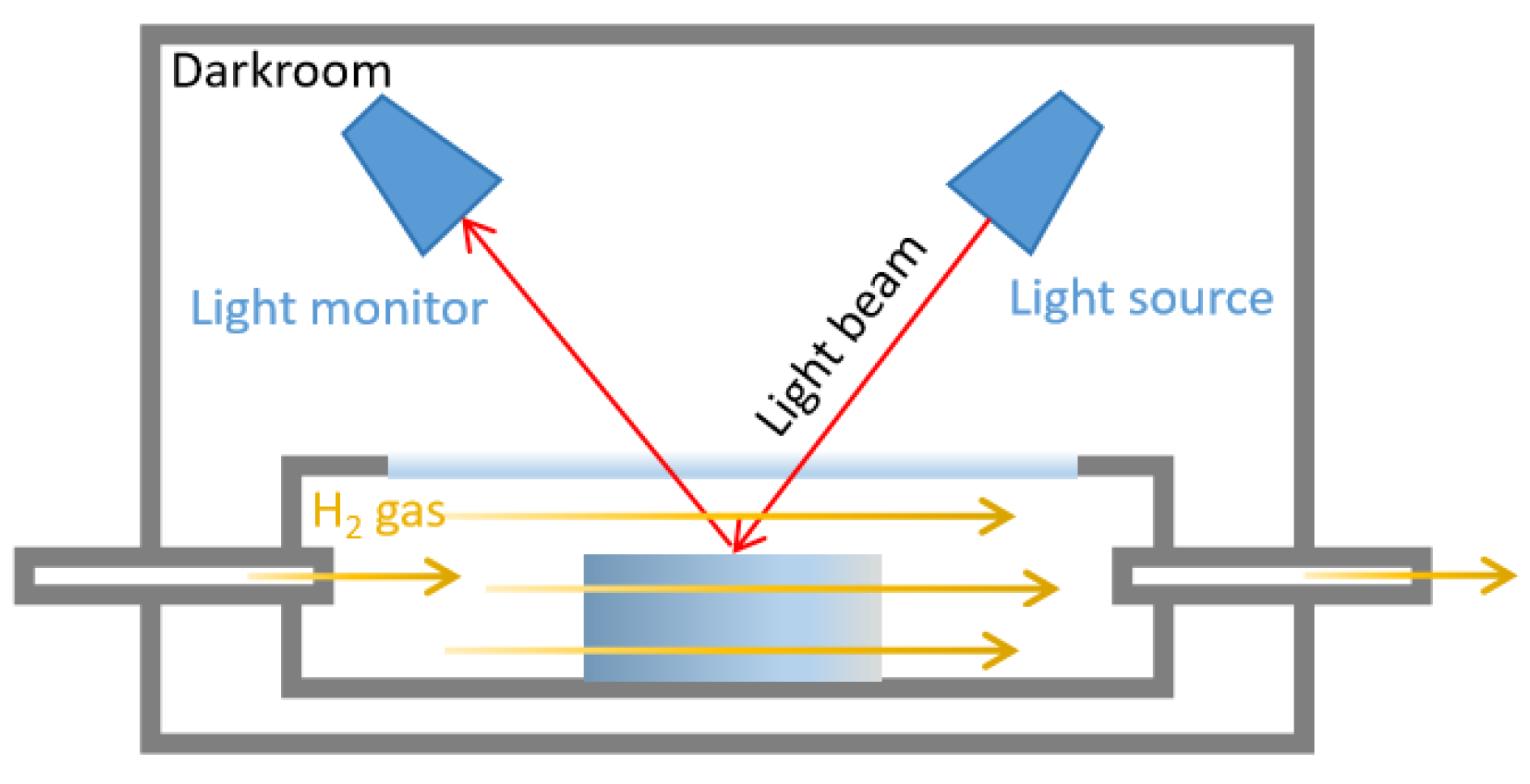
| WO3 phr a | Density (g/cm3) | Hardnesss (Shore A) | Tensile Strength (MPa) | Elongation at Break (%) | Crosslinking Density (mol/cm3) | Creep (%) |
|---|---|---|---|---|---|---|
| 0 | 1.124 | 62.0 | 6.66 | 583 | 1.27 | 11.4 |
| 1 | 1.133 | 62.7 | 7.14 | 650 | 0.96 | 12.9 |
| 2 | 1.139 | 63.1 | 8.07 | 735 | 0.69 | 15.9 |
| 3 | 1.155 | 63.4 | 7.65 | 760 | 0.59 | 19.3 |
| 4 | 1.181 | 64.2 | 7.45 | 765 | 0.40 | 24.1 |
| WO3 phr a | Permeability × 10−8 (cm3∙cm/cm2∙s∙cmHg) | Diffusion × 10−5 (cm2/s) | Solubility × 10−4 (cm3/cm3∙cmHg) |
|---|---|---|---|
| 0 | 2.12 | 5.35 | 3.96 |
| 1 | 1.49 | 6.69 | 2.23 |
| 2 | 1.7 | 7.29 | 2.33 |
| 3 | 1.76 | 8.16 | 2.16 |
| 4 | 1.77 | 8.81 | 2.01 |
| Ingredients/phr | 1 | 2 | 3 | 4 | 5 |
|---|---|---|---|---|---|
| SR | 100 | 100 | 100 | 100 | 100 |
| WO3 | 0 | 1 | 2 | 3 | 4 |
Disclaimer/Publisher’s Note: The statements, opinions and data contained in all publications are solely those of the individual author(s) and contributor(s) and not of MDPI and/or the editor(s). MDPI and/or the editor(s) disclaim responsibility for any injury to people or property resulting from any ideas, methods, instructions or products referred to in the content. |
© 2024 by the authors. Licensee MDPI, Basel, Switzerland. This article is an open access article distributed under the terms and conditions of the Creative Commons Attribution (CC BY) license (https://creativecommons.org/licenses/by/4.0/).
Share and Cite
Wang, L.; Yang, K.; Yu, P.; Liu, H.; Cheng, Q.; Yu, A.; Liu, X.; Yang, Z. Characterization of WO3/Silicone Rubber Composites for Hydrogen-Sensitive Gasochromic Application. Molecules 2024, 29, 3499. https://doi.org/10.3390/molecules29153499
Wang L, Yang K, Yu P, Liu H, Cheng Q, Yu A, Liu X, Yang Z. Characterization of WO3/Silicone Rubber Composites for Hydrogen-Sensitive Gasochromic Application. Molecules. 2024; 29(15):3499. https://doi.org/10.3390/molecules29153499
Chicago/Turabian StyleWang, Lin, Ke Yang, Ping Yu, Huan Liu, Qingli Cheng, Anfeng Yu, Xinmei Liu, and Zhe Yang. 2024. "Characterization of WO3/Silicone Rubber Composites for Hydrogen-Sensitive Gasochromic Application" Molecules 29, no. 15: 3499. https://doi.org/10.3390/molecules29153499






